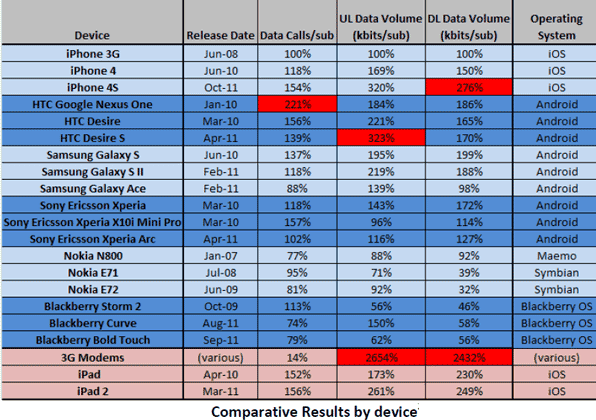iPhone 4S is as data hungry as three iPhone 3Gs
The typical Apple iPhone 4S user is equivalent to two iPhone 4 users and three iPhone 3G users in terms of data demand, according to a report released Friday.
January 6, 2012

The typical Apple iPhone 4S user is equivalent to two iPhone 4 users and three iPhone 3G users in terms of data demand, according to a report released Friday.
Network optimisation firm Arieso, reported the findings in a research paper following a similar study carried out by the firm in 2010. The company’s CTO, Michael Flanagan, who briefed telecoms.com on the report expressed some surprise at the headline finding – that the iPhone 4S is the hungriest handset on the market – especially given the rise of Android over the past 12 months.
The study was carried out on the data demands of over 1.1 million distinct subscribers over a single, 24 period in a Tier-1 market with a mixture of urban and suburban morphologies, focusing on popular devices which were represented by at least 1000 subscribers. The iPhone 3G was chosen as a “normalised benchmark,” although the study found that different users and different devices exhibit very different demands on the network.
Android is picking up the pace however, according to the findings, the Google Nexus One by HTC has twice the data calls per subscriber compared to the iPhone 3G. By way of comparison, the iPhone 4S shows 54 per cent more data calls per subscriber than the iPhone 3G. Greater ease of use arguments may apply to both devices here but Flanagan also warns not to discount the operating system and related, potentially excessive, signalling demands of the smartphone on the number of data calls. Something that remains a topic of on-going study by network operators.
The HTC Desire S revealed a dramatic 223per cent increase in uplink data volumes per subscriber compared to the iPhone 3G. Increases in uplink data volumes are largely expected to be due to corresponding increases in user generated content, and the Desire S may be significant in its implementation of higher speed HSPA+ connectivity on both the uplink and downlink.
Data downlink volumes are still rising of course. The iPhone 4S showed an increase of 176 per cent in downlink data volumes over the iPhone 3G, quantifying the importance of the metric for purposes of network planning and optimisation. Flanagan notes that the device appears to unleash data consumption behaviours that have no precedent.
Indeed, following on from the 2010 study, Arieso’s latest analysis reveals that so called ‘extreme’ users are becoming even more extreme, with just one per cent of subscribers now consuming half of all downloaded data. The vast majority of these are dongle users treating their connection as they would fixed line broadband but 33 per cent are smartphone users and the remaining three per cent are tablet users. Usage in these cases tends to be stationary rather than mobile, so Flanagan suggests that these users might be prime targets for femtocells, or in some cases, just getting rid of.

On a related note, Flanagan suggested an application of such data mining, which operators can and should be doing on a regular basis, in helping them recommend devices to customers. “Say a certain customer comes in to upgrade his device to a smartphone and tells you where he spends most of his time. The operator looks on a map and sees the usage profiles for that particular area. The result might mean some devices are more appropriate ones for this person to move towards than others. It’s an informed piece of advice and can be used to manage expectations at the point of sale.”
About the Author
You May Also Like












_1.jpg?width=300&auto=webp&quality=80&disable=upscale)
